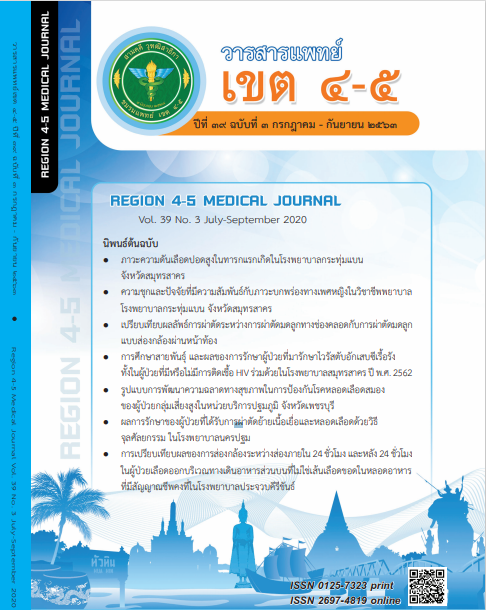Positive Parenting of Parents with ADHD Children in Ratchaburi Hospital
Keywords:
positive parenting, ADHD, parentAbstract
ABSTRACT
Objectives: The aims of this study were1) to examine the positive parenting of parent with ADHD children who received treatment at Ratchaburi Hospital 2) to study the association factors of positive parenting 3) to examine the relationship between positive parenting and the severity of ADHD
Method: This study was a cross sectional descriptive study. Data was collected by reviewing of medical records of 277 ADHD patients aged between 6 - 18 years old, who came for treatment at child and adolescent psychiatry clinic, Ratchaburi Hospital from October 1, 2018 to September 30, 2019. The instruments used were self-demographic data, Positive Parenting Questionnaire and SNAP-IV. The Data were analyzed using descriptive statistic, percentage, arithmetic mean, standard deviation, correlation coefficient and multiple regression analysis.
Result: The findings indicated that the sample had positive parenting with a mean of 26.75. It was also found that positive parenting was significantly related to the understanding relationship between family members (Pearson’s correlation = 0.351, p value < .01) but was a not correlated to the severity of ADHD. When analyzed using regression analysis, It was found out that the understanding relationship between family members was a significant predictor of the positive parenting with a mean of 12% and a regression coefficients at 1.88
Conclusion: Parents of ADHD patients at Ratchaburi Hospital had positive parenting score fell within below – moderate level which the predictor factor was the understanding relationship between family members.
References
2. Daley D, Birchwood J. ADHD and academic performance: why does ADHD impact on academic performance and what can be done to support ADHD children in the classroom?.Child Care Health Dev. 2010;36(4): 455–64.
3. LiffordKJ, HaroldGT, Thapar A. Parent–child hostility and child ADHD symptoms: A genetically sensitive and longitudinal analysis. J Child Psychol Psychiatry. 2009;50(12): 1468–76.
4. Mrug S, Hoza B, Gerdes AC. Children with attention-deficit/hyperactivity disorder: Peer relationships and peer-oriented interventions. New Dir Child Adolesc Dev. 2001; (91): 51-77.
5. Storebø OJ, Simonsen E. The Association Between ADHD and Antisocial Personality Disorder (ASPD): A Review. J Atten Disord. 2016;20(10):815–24.
6. Posner K, Melvin GA, Murray DW, et al.Clinical presentation of attention-deficit/hyperactivity disorder in preschool children: The preschoolers with attention-deficit/hyperactivity treatment study (PATS). J Child AdolescPsychopharmacol. 2007;17(5): 547–62.
7. Barkley RA, Fischer M, Smallish L, et al. Young adult outcome of hyperactive children: adaptive functioning in major life activities. J Am Acad Child Adolesc Psychiatry. 2006;45(2):192–202.
8. Hechtman L, Swanson JM, Sibley MH, et al.Functional Adult Outcomes 16 Years After Childhood Diagnosis of Attention-Deficit/Hyperactivity Disorder: MTA Results. J Am Acad Child Adolesc Psychiatry. 2016;55(11): 945-52.e2.
9. Laugesen B, Lauritsen MB, Jørgensen R, et al. Living with a child with attention deficit hyperactivity disorder: a systematic review. Int J Evid Based Healthc. 2016;14(4): 150–65.
10. Galambos NL, Barker ET, Almeida DM. Parents do matter: Trajectories of change in externalizing and internalizing problems in early adolescence. Child Dev. 2003;74(2): 578–94.
11. Brody GH, Murry VM, Kim S, et al. Longitudinal pathways to competence and psychological adjustment among African American children living in rural single–parent households. Child Dev. 2002;73(5): 1505–16.
12. Denham SA, Workman E, Cole PM, et al. Prediction of externalizing behavior problems from early to middle childhood: The role of parental socialization and emotion expression. Dev Psychopathol. 2000;12(1):23–45.
13. Burke JD, Pardini DA, Loeber R. Reciprocal relationships between parenting behavior and disruptive psychopathology from childhood through adolescence. J Abnorm Child Psychol. 2008;36(5): 679–92.
14. Hazell P. Review of attention-deficit/hyperactivity disorder comorbid with oppositional defiant disorder. Australas Psychiatry. 2010;18(6): 556–9.
15. Hinshaw SP. Conduct disorder in childhood: Conceptualization, diagnosis, comorbidity, and risk status for antisocial functioning in adulthood. Prog Exp Pers Psychopathol Res. 1994;3–44.
16. Pliszka S. Practice Parameter for the Assessment and Treatment of Children and Adolescents With Attention-Deficit/Hyperactivity Disorder. J Am Acad Child Adolesc Psychiatry.2007;46(7):894–921.
17. Harvey E, Stoessel B, Herbert S. Psychopathology and parenting practices of parents of preschool children with behavior problems. Parenting. 2011;11(4): 239–63.
18. Murray L, Creswell C, Cooper PJ. The development of anxiety disorders in childhood: an integrative review. Psychol Med. 2009;39(9): 1413–23.
19. Grant KE, Compas BE, Stuhlmacher AF, et al. Stressors and child and adolescent psychopathology: Moving from markers to mechanisms of risk. Psychol Bull. 2003;129(3):447-66.
20. Buehler C, Gerard JM. Marital conflict, ineffective parenting, and children’s and adolescents’ maladjustment. J Marriage Fam. 2002;64(1):78–92.
21. Anderson KE, Lytton H, Romney DM. Mothers’ interactions with normal and conduct-disordered boys: Who affects whom?. Dev Psychol. 1986;22(5):604-9.
22. Johnston C, Jassy JS. Attention-deficit/hyperactivity disorder and oppositional/conduct problems: Links to parent-child interactions. J Can Acad Child Adolesc Psychiatry. 2007;16(2):74-9.
23. Rimestad ML, Lambek R, Zacher Christiansen H, et al. Short-and long-term effects of parent training for preschool children with or at risk of ADHD: A systematic review and meta-analysis. J Atten Disord. 2019; 23(5): 423–34.
24. Pityaratstian N, Booranasuksakul T, Juengsiragulwit D, et al. ADHD screening properties of the Thai version of Swanson, Nolan, and Pelham IV scale (SNAP-IV) and Strengths and Difficulties Questionnaire (SDQ). J PsychiatrAssocThail. 2014;59(2):97–110.
25. Huth-Bocks AC, Hughes HM. Parenting stress, parenting behavior, and children’s adjustment in families experiencing intimate partner violence. J Fam Violence. 2008; 23(4): 243–51.
26. Burlaka V, Graham-Bermann SA, Delva J. Family factors and parenting in Ukraine. Child Abuse Negl. 2017 ;72: 154–62. doi: 10.1016/j.chiabu.2017.08.007
27. รศ.นพ.ชาญวิทย์ พรนภดล. แบบสอบถามการเลี้ยงดูเชิงบวก (Positive Parenting Questionnaire: PPQ)พัฒนาโดย ชาญวิทย์ พรนภดล และคณะ. กรุงเทพฯ: คณะแพทยศาสตร์ศิริราชพยาบาล มหาวิทยาลัยมหิดล; 2556.
Downloads
Published
How to Cite
Issue
Section
License
ลิขสิทธิ์บทความเป็นของผู้เขียนบทความ แต่หากผลงานของท่านได้รับการพิจารณาตีพิมพ์ลงวารสารแพทย์เขต 4-5 จะคงไว้ซึ่งสิทธิ์ในการตีพิมพ์ครั้งแรกด้วยเหตุที่บทความจะปรากฎในวารสารที่เข้าถึงได้ จึงอนุญาตให้นำบทความในวารสารไปใช้ประโยชน์ได้ในเชิงวิชาการโดยจำเป็นต้องมีการอ้างอิงถึงชื่อวารสารอย่างถูกต้อง แต่ไม่อนุญาตให้นำไปใช้ในเชิงพาณิชย์




